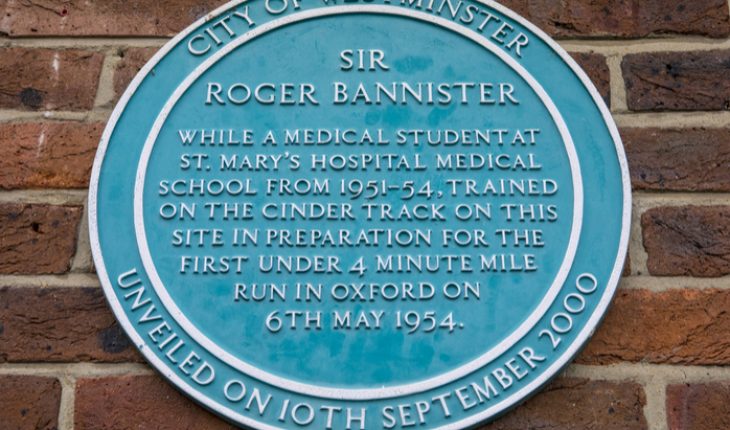A Tribute to Sir Roger Bannister (1929 – 2018), a towering 20th figure of sport and medicine who went down in history for running the first four-minute mile – but he placed more value on his lifetime achievements as a neurologist at St Mary’s Hospital, London.
“The man who can drive himself further once the effort gets painful is the man who will win.” ― Roger Bannister
One of the most inspiring men in history, Sir Roger Bannister, a distinguished neurologist, who spent much of his life working at St Mary’s Hospital, London, has died on 3rd March, aged 88.
On 6 May 1954 Bannister became the first man to run a mile in under four minutes, the most stunning athletic achievement of the 20th century and it established him as one of the most famous sportsmen in history.
On 6 May 1954 Bannister became the first man to run a mile in under four minutes, the most stunning athletic achievement of the 20th century and it established him as one of the most famous sportsmen in history.
‘It was a target. University athletes had been trying for years and it just didn’t seem capable of being broken. There was a magic about four symmetrical laps of one minute each. It was just something that caught the public’s imagination,’ explained Bannister modestly. Despite his athletic achievements, he gave up competitive athletics once he started clinical studies, as his greater ambition was to pursue his medical career.
Born in Harrow, in 1929, Sir Roger Bannister started athletics at the age of 17. He studied medicine at Oxford where his athletic potential wasn’t immediately recognised. Fellow Oxford medical student, Dr Thomas Stuttaford was introduced to Bannister, at Oxford, two years his senior and then doing research. Already a legend, Bannister was very friendly to him. The two men met again half a century later when Dr Stuttaford returned to Oxford to interview Bannister for ‘The Oldie’ magazine. To Dr Stuttaford’s surprise, Bannister explained that he his athletic potential hadn’t been immediately recognised at Oxford: ‘The university groundsman looked at me and another freshman, a rowing man and then exclaimed, “You, sir, might become a runner,” looking at the oarsman, and then turned to me, sighed and said: “But I’m afraid you will never be any good. You just haven’t the strength of the build for it,” he said with a smile.
On the day he broke the 4 minute mile Bannister worked his usual shift at St Mary’s Hospital, where he was a medical student, before sharpening his racing spikes and taking the mid-morning train from Paddington to Oxford. The race billed as “The Miracle Mile” took place at 6pm, watched by around 3,000 spectators.
On the day he broke the 4 minute mile Bannister worked his usual shift at St Mary’s Hospital, where he was a medical student, before sharpening his racing spikes and taking the mid-morning train from Paddington to Oxford. The race billed as “The Miracle Mile” took place at 6pm, watched by around 3,000 spectators.
‘It was very windy and the race was nearly cancelled,’ said Bannister. His arch-rival Landy led the race until the final bend when he made the mistake of looking back to seeing how Bannister was doing. Bannister surged ahead to breast the tape in 3:58.8. His world record described as the ‘Everest of athletics’ stood for just 46 days, beaten when Landy ran 3:57.4 in Finland.
‘Bannister always intended to give up professional running as soon as he ceased to be a medical student,’ says Dr Stuttaford. He saw athletics as something to be done in his spare time – a hobby – rather than a career. A few months after his world victory, he retired from competitive sport and dedicated himself to medicine. He attended St Mary’s Medical School, now part of Imperial College, London and was a consultant physician within ten years. Later he became a leading neurologist at St. St Mary’s Hospital and the Western Ophthalmic Hospital.
When asked by Dr Stuttaford whether the 4-minute mile was his life’s greatest achievement, Bannister answered that he “felt prouder of his achievements as a neurologist and in research into the nervous system”. He produced many important papers on neurology. It was sadly ironic that Bannister developed Parkinson’s disease seven years ago.
Sir Roger Bannister received a knighthood in 1975. From 1971-74 he acted as Chairman of the first executive Sports Council and helped develop the drugs test for the anabolic steroids, a test still used today. He left St Mary’s in 1985 to become Master of Pembroke College, but maintained his strong links. He later became Chairman of the St Mary’s Hospital Medical School Development Trust and opened the Roger Bannister Lecture Theatre in 2004, where his portrait presides over the room today, inspiring today’s generation of Imperial’s medical students.
Sir Roger Bannister died peacefully in Oxford on 3 March 2018 surrounded by his loving family: he is mourned by his friends and medical colleagues.
- People’s Choice Victory for Down’s Syndrome Scotland Garden at Chelsea 2025 - 28th May 2025
- Cadogan: A Chelsea Family By Tamsin Perrett - 3rd May 2025
- Dream Worlds a new exhibition in Cambridge - 14th December 2024







